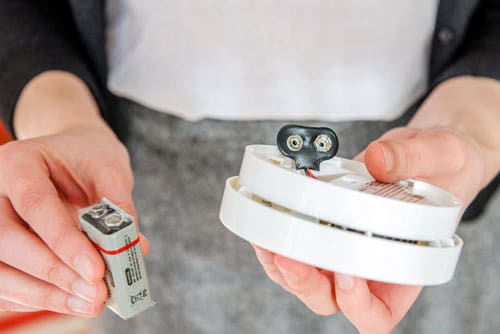Daylight Savings Time Signals an Essential Home Safety Tip

It's time to set your clocks back an hour and change the batteries in your smoke and carbon monoxide detectors.
An essential reminder for home safety
Daylight savings time (DST) begins November 6, 2022, at 2:00 am. This day reminds us to reset our clocks (fall back 1 hour in the fall of the year). It also reminds us of an essential home safety tip.
DST reminds us to replace the batteries in smoke and carbon monoxide (CO) detectors in our homes. It's an important reminder because these detection devices are useless without working batteries.
The threat of home fires, most often caused by cooking and heating equipment, increases with the holidays and cold weather.
The production of CO occurs whenever a material burns. Homes with attached garages or fuel-burning appliances are more likely to have CO problems.
Typical sources of CO in our homes include:
- Clothes dryers
- Water heaters
- Furnaces or boilers
- Fireplaces, both gas and wood burning
- Gas stoves and ovens
- Motor vehicles
- Grills, generators, power tools, lawn equipment
- Wood stoves
- Tobacco smoke
Why are smoke detectors more critical than ever to home safety?
Prioritizing home safety is more important now than ever, and smoke detectors are paramount in this effort.
For example, research shows that 30 years ago, a person had about 17 minutes to escape a house fire. Today, most people only have about three or four minutes to get out of a burning house. This limited time is primarily due to the increased use of synthetic materials in modern homes and furniture.
John Drengenberg, the Consumer Safety Director for Underwriters Laboratories, offers the following explanation: "The backing of your carpet is synthetic, your drapes are synthetic, the couch, the pillows are synthetic. They burn hotter and faster than natural materials do."
Drengenberg also offers this warning, "When your smoke alarm goes off, you don't have time to look around and get your wedding pictures. You get out as quickly as you can."
Do smoke and carbon monoxide detectors make a difference?
Operational smoke and carbon monoxide detectors can mean the difference between life and death.
According to a 2019 report from the National Fire Protection Association (NFPA), three out of five deaths caused by fire occurred in homes where smoke detectors were not installed or not working.
Sadly, the report also indicated that in situations where smoke detectors failed to work. What’s more, nearly half were simply missing batteries or not connected properly.
Additionally, the Centers for Disease Control and Prevention (CDC) reports that CO poisoning causes approximately 430 deaths annually in the United States. CO poisoning is also responsible for approximately 50,000 emergency room visits annually.
Guidelines for smoke and carbon monoxide detectors
The National Fire Alarm and Signaling Code requires the installation of a working smoke detector in every room used for sleeping and outside every sleeping area. It also requires a smoke detector on every level of the house, including the basement.
If you have any appliances in your home that use wood or natural gas for fuel, you should have at least one CO detector. Like the smoke detectors, you should also change the batteries in your CO detector when you change your clocks for daylight savings time.
Test devices after replacing the batteries
Finally, be sure your smoke and CO detectors actually work. After you’ve installed fresh batteries in your devices, test them. If the detector fails to produce the expected alert, replace the device ASAP.
The Moultrie County Health Department encourages you to change the batteries in your smoke and CO detectors this fall while setting your clocks back 1 hour for DST on November 6.
Remember: When it comes to detecting a smoke or CO threat, a few minutes of warning could save your life.

